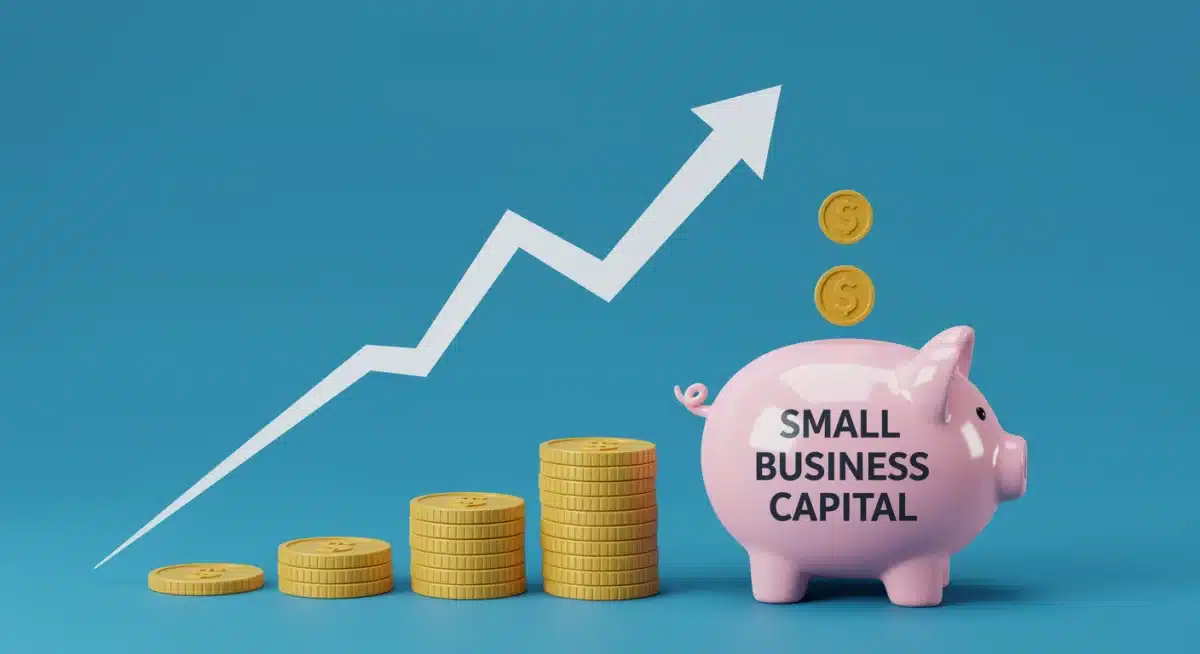2025 Fed Rate Hikes: Small Business Lending Impact

The 2025 Federal Reserve interest rate hikes are poised to significantly reshape the landscape of small business lending in the U.S., influencing borrowing costs and access to capital for entrepreneurs nationwide.
Understanding the implications of the 2025 Federal Reserve interest rate hikes is paramount for every small business owner in the U.S. These anticipated changes are not merely abstract economic shifts; they directly influence your access to capital, the cost of borrowing, and ultimately, your business’s growth trajectory. This article delves into how these monetary policy adjustments will reshape the small business lending environment, offering insights to help you prepare and adapt.
The Federal Reserve’s Role and Monetary Policy Tools
The Federal Reserve, often called the Fed, serves as the central bank of the United States. Its primary mandate is to maintain maximum employment, stable prices, and moderate long-term interest rates. To achieve these goals, the Fed employs various monetary policy tools, with interest rate adjustments being among the most impactful. These decisions reverberate throughout the economy, affecting everything from consumer spending to business investments.
When the Fed adjusts interest rates, it typically targets the federal funds rate, which is the rate at which banks lend reserves to each other overnight. Changes to this benchmark rate influence other interest rates across the economy, including those on loans for small businesses. A hike in the federal funds rate generally leads to higher borrowing costs for commercial banks, which then pass these increased costs on to their customers, including small businesses seeking loans.
Understanding the Fed’s Mandate
The dual mandate of the Federal Reserve is critical to comprehending its actions. Price stability means keeping inflation in check, while maximum employment refers to a healthy job market. These two objectives often require a delicate balancing act, and the Fed’s decisions in 2025 will likely reflect its ongoing assessment of these economic indicators.
- Inflation Control: Raising interest rates is a common strategy to cool down an overheating economy and combat inflation by making borrowing more expensive, thereby reducing demand.
- Employment Levels: While rate hikes can curb inflation, excessive increases might slow economic growth too much, potentially impacting employment.
- Economic Stability: The Fed aims for a stable economic environment, avoiding erratic swings in growth or prices.
The Fed’s communication and forward guidance are also crucial. By signaling potential future rate changes, the Fed attempts to manage market expectations and provide businesses and consumers with time to adjust their financial planning. This transparency, while not always perfect, is an important component of its policy toolkit.
Anticipated 2025 Federal Reserve Interest Rate Hikes: The Macro View
Forecasting interest rate movements is inherently complex, as it depends on a multitude of economic factors including inflation, employment data, global economic conditions, and geopolitical events. However, economists and market analysts often provide projections based on current trends and the Federal Reserve’s past behavior. For 2025, many anticipate a period of continued vigilance from the Fed, potentially involving further rate adjustments.
The rationale behind potential 2025 Fed rate hikes typically stems from persistent inflationary pressures or an exceptionally robust economy that risks overheating. If inflation remains stubbornly above the Fed’s target, or if wage growth and consumer demand continue to outpace supply, further tightening of monetary policy through rate increases becomes a likely scenario. These macro-level decisions have direct micro-level consequences for small businesses.
Factors Driving Future Rate Decisions
Several key economic indicators will heavily influence the Federal Reserve’s decisions regarding interest rates in 2025. Monitoring these factors can provide small business owners with a clearer picture of the economic winds ahead.
- Inflation Data: Consumer Price Index (CPI) and Personal Consumption Expenditures (PCE) are closely watched. Sustained high readings will pressure the Fed to act.
- Employment Reports: Non-farm payrolls, unemployment rates, and wage growth figures indicate the health of the labor market. A tight labor market can contribute to inflationary pressures.
- GDP Growth: Robust economic growth might necessitate rate hikes to prevent overheating.
- Global Economic Health: International events and economic performance can indirectly influence U.S. monetary policy.
Understanding these drivers allows small business owners to not just react to policy changes, but to anticipate them and plan accordingly. The interconnectedness of global and domestic economies means that these factors are constantly in flux, requiring ongoing attention.
Direct Impact on Small Business Borrowing Costs
When the Federal Reserve raises interest rates, the cost of borrowing for small businesses typically increases across various loan products. This is one of the most immediate and tangible effects of monetary policy tightening. Whether a business is seeking a new loan, refinancing existing debt, or relying on a line of credit, higher benchmark rates translate into higher interest payments.
For small businesses that are already operating on tight margins, even a modest increase in interest rates can significantly impact their profitability and cash flow. This means that the capital required for expansion, inventory purchases, equipment upgrades, or even day-to-day operations becomes more expensive. Consequently, some businesses might postpone investments or scale back growth plans in response to these elevated costs.
Loan Products Most Affected
Different types of small business loans react to interest rate changes in varying degrees. Understanding these nuances can help businesses choose the most suitable financing options.
- Variable-Rate Loans: These loans, such as lines of credit or certain SBA loans, are directly tied to benchmark rates like the prime rate. As the Fed raises rates, the interest payments on these loans will increase.
- Fixed-Rate Loans: While existing fixed-rate loans are unaffected, new fixed-rate loans will be offered at higher interest rates. This makes securing new capital more costly.
- Commercial Mortgages: Interest rates on commercial real estate loans, often long-term, are also influenced by the broader interest rate environment, impacting property acquisition or refinancing.
The cumulative effect of these higher borrowing costs can be substantial, particularly for businesses that rely heavily on debt financing. It underscores the importance of proactive financial planning and exploring alternative funding avenues.

Access to Capital and Lending Standards
Beyond the direct increase in borrowing costs, 2025 Federal Reserve interest rate hikes can also influence the overall availability of capital for small businesses and the stringency of lending standards. When interest rates rise, banks may become more cautious in their lending practices. Higher rates increase the risk of default for borrowers, prompting lenders to tighten their criteria for approving loans.
This tightening can manifest in various ways: banks might require higher credit scores, demand more collateral, or reduce the maximum loan amounts they are willing to offer. For small businesses, particularly startups or those with less established financial histories, this could mean that securing a loan becomes significantly more challenging, even if they are willing to pay the higher interest rates.
How Lending Standards Evolve
The ripple effect of Fed rate hikes extends to the cautiousness of lenders. This shift in risk appetite can create a more difficult environment for small businesses seeking financing.
- Increased Scrutiny: Lenders will likely perform more thorough due diligence on loan applications, scrutinizing business plans, cash flow projections, and creditworthiness more intensely.
- Higher Collateral Requirements: To mitigate increased risk, banks may demand more significant collateral or personal guarantees from business owners.
- Reduced Loan-to-Value Ratios: For secured loans, lenders might offer a lower percentage of the asset’s value, requiring businesses to contribute more equity.
- Preference for Established Businesses: Newer businesses or those in higher-risk sectors may find it particularly difficult to secure financing compared to more established, proven enterprises.
This environment necessitates that small businesses present an exceptionally strong financial case to potential lenders, emphasizing solid business models, robust cash flow, and a clear repayment strategy. Proactive engagement with financial advisors and careful preparation of loan applications will be more crucial than ever.
Strategies for Small Businesses to Navigate Higher Rates
In anticipation of or response to the 2025 Federal Reserve interest rate hikes, small businesses must adopt proactive strategies to mitigate the negative impacts and maintain financial health. This involves a comprehensive review of current financial practices, exploring alternative financing, and optimizing operational efficiency.
One primary strategy involves a thorough audit of existing debt. Businesses with variable-rate loans should assess the potential increase in payments and consider options for refinancing into fixed-rate loans if market conditions allow, thereby locking in predictable payments. For new borrowing, a careful comparison of different lenders and loan products will be essential to secure the most favorable terms possible in a rising rate environment.
Key Adaptation Measures
Navigating a period of higher interest rates requires a multi-faceted approach. Businesses should consider the following actionable steps:
- Review and Optimize Cash Flow: Enhance cash flow management by accelerating receivables, negotiating extended payment terms with suppliers, and closely monitoring expenses. Strong cash flow reduces reliance on external financing.
- Explore Alternative Financing: Look beyond traditional bank loans. Options like SBA loans, microloans, community development financial institutions (CDFIs), or even crowdfunding might offer more favorable terms or greater accessibility.
- Strengthen Credit Profile: Improve personal and business credit scores. A strong credit profile can help secure better interest rates, even in a tightening market.
- Increase Efficiency and Profitability: Focus on operational efficiencies to reduce costs and boost profit margins. This can help absorb higher borrowing costs without significantly impacting the bottom line.
- Build Financial Reserves: Accumulate a cash reserve to reduce the need for external financing during periods of high interest rates or economic uncertainty.
- Consult Financial Experts: Engage with financial advisors or business consultants who specialize in small business finance. They can provide tailored advice and help identify suitable strategies.
By implementing these strategies, small businesses can enhance their resilience and position themselves for continued growth, even amidst challenging economic conditions.
Long-Term Economic Outlook and Small Business Resilience
While the immediate focus is on the impact of 2025 Federal Reserve interest rate hikes, it is equally important for small businesses to consider the long-term economic outlook. Monetary policy decisions, including rate hikes, are ultimately aimed at fostering sustainable economic growth and stability. Though potentially challenging in the short term, these adjustments can contribute to a healthier economic environment in the long run.
Small businesses have historically demonstrated remarkable resilience and adaptability in the face of economic shifts. Those that can effectively manage their finances, innovate their products or services, and maintain strong customer relationships are best positioned to thrive. The current environment presents an opportunity for businesses to re-evaluate their models, identify areas for improvement, and build stronger, more sustainable operations.
Building Sustainable Business Models
Long-term success in a dynamic economic landscape hinges on foresight and strategic planning. Businesses should focus on building models that can withstand various economic cycles.
- Diversify Revenue Streams: Relying on a single product or customer segment can be risky. Exploring new markets or offerings can create a more stable revenue base.
- Invest in Technology: Leveraging technology can improve efficiency, reduce costs, and enhance customer experience, providing a competitive edge.
- Foster Customer Loyalty: A loyal customer base provides a buffer against economic downturns and fluctuations in demand.
- Strategic Partnerships: Collaborating with other businesses can open new opportunities, share resources, and reduce individual risk.
- Continuous Learning and Adaptation: The business environment is constantly evolving. Staying informed about market trends and economic forecasts is vital for making timely adjustments.
Ultimately, the ability of small businesses to navigate the changes brought about by the 2025 Fed rate hikes and subsequent economic conditions will depend on their strategic agility and commitment to sound financial management. These challenges, while daunting, often spur innovation and lead to stronger, more efficient enterprises.

| Key Point | Brief Description |
|---|---|
| Increased Borrowing Costs | Higher Fed rates translate to more expensive new loans and increased payments on variable-rate debt for small businesses. |
| Tighter Lending Standards | Banks may become more cautious, requiring stronger credit profiles and more collateral, potentially limiting access to capital. |
| Strategic Adaptation Needed | Businesses must optimize cash flow, explore alternative financing, and strengthen credit to mitigate impacts. |
| Focus on Resilience | Long-term success depends on diversifying revenue, investing in technology, and fostering customer loyalty amidst economic shifts. |
Frequently Asked Questions About 2025 Fed Rate Hikes
Fed rate hikes increase the federal funds rate, which banks use as a benchmark. This typically leads to higher prime rates, directly increasing interest rates on variable-rate small business loans and making new fixed-rate loans more expensive.
Variable-rate loans, such as lines of credit, certain Small Business Administration (SBA) loans, and revolving credit facilities, are most sensitive. Their interest rates adjust periodically in response to changes in benchmark rates like the prime rate.
Potentially, yes. Higher rates can lead banks to tighten lending standards due to increased default risk. This may mean stricter credit requirements, higher collateral demands, and greater scrutiny of business financials for loan approval.
Prepare by optimizing cash flow, strengthening your credit profile, exploring alternative financing options, and negotiating favorable terms on existing debt. Consider fixed-rate refinancing if appropriate to lock in current rates.
Look into SBA-backed loans, microloans from non-profits, community development financial institutions (CDFIs), online lenders, or even crowdfunding platforms. Each offers different criteria and potentially more flexible terms.
Conclusion
The anticipated 2025 Federal Reserve interest rate hikes represent a significant economic development that small businesses across the U.S. must carefully consider. While these adjustments are designed to foster long-term economic stability, they undeniably introduce challenges related to borrowing costs and access to capital. By understanding the Fed’s motivations, anticipating the direct and indirect impacts, and proactively implementing strategic financial measures, small business owners can not only mitigate potential risks but also position their enterprises for sustained growth and resilience in a dynamic economic landscape. Staying informed and adaptable will be key to navigating the evolving lending environment effectively.





